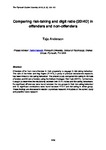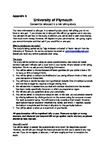Comparing risk-taking and digit ratio (2D:4D) in offenders and non-offenders
| dc.contributor.author | Anderson, T. | |
| dc.date.accessioned | 2019-05-15T13:20:13Z | |
| dc.date.available | 2019-05-15T13:20:13Z | |
| dc.date.issued | 2012 | |
| dc.identifier.citation |
Anderson, T. (2012) 'Comparing risk-taking and digit ratio (2D:4D) in offenders and non-offenders', The Plymouth Student Scientist, 5(2), p. 105-120. | en_US |
| dc.identifier.issn | 1754-2383 | |
| dc.identifier.uri | http://hdl.handle.net/10026.1/13986 | |
| dc.description.abstract |
Offenders differ from non-offenders in their propensity to engage in risk-taking behaviour. The ratio of the index and ring fingers (2D:4D), a proxy of prenatal testosterone exposure, has been linked to risk-taking behaviour. The present study compared risk-taking in 45 male offenders and 66 non-offenders using the Balloon Analogue Risk Task (BART). Furthermore, it sought to determine the relationship between their 2D:4D ratios and risk-taking behaviours. No significant differences were found between the two groups in their risk-taking behaviour and no significant correlations were found between 2D:4D and risk-taking in either group. These findings are discussed in relation to previous research, limitations of the current study and possible future research. | en_US |
| dc.language.iso | en | en_US |
| dc.publisher | University of Plymouth | |
| dc.rights | Attribution 3.0 United States | * |
| dc.rights.uri | http://creativecommons.org/licenses/by/3.0/us/ | * |
| dc.subject | Offenders | en_US |
| dc.subject | non-offenders | en_US |
| dc.subject | risk-taking behaviour | en_US |
| dc.subject | prenatal testosterone exposure | en_US |
| dc.subject | Balloon Analogue Risk Task | en_US |
| dc.title | Comparing risk-taking and digit ratio (2D:4D) in offenders and non-offenders | en_US |
| dc.type | Article | |
| plymouth.issue | 2 | |
| plymouth.volume | 5 | |
| plymouth.journal | The Plymouth Student Scientist |




